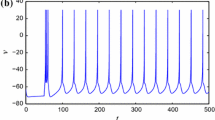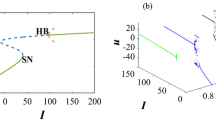Abstract
Considering the individual differences between neurons, the fractional-order framework is introduced, and the neurons with various orders denote the individual differences during the cell differentiation. In this paper, the fractional-order FithzHugh–Nagumo (FHN) neural circuit is used to reproduce the firing patterns. In addition, an energy balance strategy is applied to determine the inter-neuronal communication. The neurons with energy imbalance exchange the information whereas the synaptic channels are blocked when energy balance is achieved. Two neurons coupled by this strategy achieve the phase synchronization and phase lock, and it indicates the two neurons generate spiking at the same time or with an interval. Similarly, the synchronization results are also obtained in the chain neuronal network, and the neurons exhibit the same firing patterns since the synchronization factor is closed to 1. Particularly, the neurons with order diversities lead to the heterogeneity and gradient field in the regular network, and the target wave is developed over time. With the wave spreading in the network, the silent states and exciting states appear in the whole network. The formation and diffusion of the target wave reveals the information transmission in neuronal network, and it indicates the individual differences paly an essential role in the collective behavior of neurons.













Similar content being viewed by others
Data availability
The data that support the findings of this study are available from the corresponding author upon reasonable request.
References
Antoniou E, Bozios P, Christou V, Tzimourta KD, Kalafatakis KG, Tsipouras M, Giannakeas N, Tzallas AT (2021) EEG-based eye movement recognition using brain-computer interface and random forests. Sensors 21(7):2339
Borisyuk GN, Borisyuk RM, Khibnik AI, Roose D (1995) Dynamics and bifurcations of two coupled neural oscillators with different connection types. Bull Math Biol 57:809–840
Braun U, Harneit A (2021) Pergola: brain network dynamics during working memory are modulated by dopamine and diminished in schizophrenia. Nat Commun 12(1):3478
De Sevilla DF, Núñez A, Buño W (2021) Muscarinic receptors, from synaptic plasticity to its role in network activity. Neuroscience 456:60–70
Di Santo S, Villegas P, Burioni R, Muñoz MA (2018) Landau–Ginzburg theory of cortex dynamics: scale free avalanches emerge at the edge of synchronization. Proc Natl Acad Sci 115(7):1356–1365
FitzHugh R (1955) Mathematical models of threshold phenomena in the nerve membrane. Bull Math Biophys 17:257–278
Goto A, Bota A, Miya K, Wang J, Tsukamoto S, Jiang X, Hirai D, Murayama M, Matsuda T, McHugh TJ et al (2021) Stepwise synaptic plasticity events drive the early phase of memory consolidation. Science 374(6569):857–863
Gria A, Legdeur N, Badissi M, Heuvel MP, Stam CJ, Visser PJ, Hillebrand A (2021) Magnetoencephalography brain signatures relate to cognition and cognitive reserve in the oldest-old: the flutamide 90+ study. Front Aging Neurosci 13:746373
Guo Y, Zhou P, Yao Z, Ma J (2021) Biophysical mechanism of signal encoding in an auditory neuron. Nonlinear Dyn 105:3603–3614
He S, Sun K, Wang H (2019) Dynamics and synchronization of conformable fractional-order hyperchaotic systems using the homotopy analysis method. Commun Nonlinear Sci Numer Simul 73:146–164
Ibrahim MM, Kamran MA, Mannan MMN, Jung IH, Kim S (2021) Lag synchronization of coupled time-delayed Fitzhugh–Nagumo neural networks via feedback control. Sci Rep 11(1):1–15
Jeong Y, Cho H-Y, Kim M, Oh J-P, Kang MS, Yoo M, Lee H-S, Han J-H (2021) Synaptic plasticity dependent competition rule influences memory formation. Nat Commun 12(1):3915
Kazanovich Y, Borisyuk R (2021) A computational model of familiarity detection for natural pictures, abstract images, and random patterns: combination of deep learning and anti-Hebbian training. Neural Netw 143:628–637
Koban L, Gianaros PJ, Kober H, Wager TD (2021) The self in context: brain systems linking mental and physical health. Nat Rev Neurosci 22(5):309–322
Li W, Chu M, Qiao J (2020) A pruning feedforward small world neural network based on katz centrality for nonlinear system modeling. Neural Netw 130:269–285
Lu L, Gao Z, Wei Z (2023a) Working memory depends on the excitatory–inhibitory balance in neuron–astrocyte network. Chaos: Interdiscip J Nonlinear Sci 1:33
Lu L, Yi M, Gao Z et al (2023b) Critical state of energy-efficient firing patterns with different bursting kinetics in temperature-sensitive Chay neuron. Nonlinear Dyn 111:1–11
Miraglia F, Vecchio F, Marra C, Quaranta D, Alù F, Peroni B, Granata G, Judica E, Cotelli M, Rossini PM (2020) Small world index in default mode network predicts progression from mild cognitive impairment to dementia. Int J Neural Syst 30(02):2050004
Miraglia F, Tomino C, Vecchio F, Alù F, Orticoni A, Judica E, Cotelli M, Rossini PM (2021) Assessing the dependence of the number of EEG channels in the brain networks’ modulations. Brain Res Bull 167:33–36
Mora-Sánchez A, Dreyfus G, Vialatte F-B (2019) Scale free behaviour and metastable brain-state switching driven by human cognition, an empirical approach. Cogn Neurodyn 13:437–452
Oliveira MM, Lourenco MV, Longo F, Kasica NP, Yang W, Ureta G, Ferreira DD, Mendonca PH, Bernales S, Ma T et al (2021) Correction of eif2-dependent defects in brain protein synthesis, synaptic plasticity, and memory in mouse models of Alzheimer’s disease. Sci Signal 14(668):5429
Peitz GW, Wilde EA, Grandhi R (2021) Magnetoencephalography in the detection and characterization of brain abnormalities associated with traumatic brain injury: a comprehensive review. Med Sci 9(1):7
Peng D, Sun KH, Alamodi AO (2019) Dynamics analysis of fractional-order permanent magnet synchronous motor and its DSP implementation. Int J Mod Phys B 33(06):1950031
Pizzo F, Roehri N, Medina Villalon S, Trèbuchon A, Chen S, Lagarde S, Carron R, Gavaret M, Giusiano B, McGonigal A et al (2019) Deep brain activities can be detected with magnetoencephalography. Nat Commun 10(1):971
Salimi Z, Moradpour F, Zarei F, Rashidi Z, Khazaei MR, Ahmadi SM (2021) The effect of blockade of androgen receptors by flutamide on learning and memory, synaptic plasticity and behavioral performances: a review study. Cell Tissue Biol 15:337–346
Sancho L, Contreras M, Allen NJ (2021) Glia as sculptors of synaptic plasticity. Neurosci Res 167:17–29
Tang X, Cai F, Ding D-X, Zhang L-L, Cai X-Y, Fang Q (2018) Magnetic resonance imaging relaxation time in Alzheimer’s disease. Brain Res Bull 140:176–189
Tyulmankov D, Yang GR, Abbott L (2022) Meta-learning synaptic plasticity and memory addressing for continual familiarity detection. Neuron 110(3):544–557
Wang S, Liang Y, Magin RL (2021a) Non-exponential relaxation models of signal decay in magnetic resonance imaging. Commun Nonlinear Sci Numer Simul 102:105928
Wang J, Tao A, Anderson WS, Madsen JR, Kreiman G (2021b) Mesoscopic physiological interactions in the human brain reveal small-world properties. Cell Rep 36(8):109585
Yao Z, Ma J, Yao Y, Wang C (2019) Synchronization realization between two nonlinear circuits via an induction coil coupling. Nonlinear Dyn 96:205–217
Yao Z, Sun K, He S (2022) Firing patterns in a fractional order Fitzhugh–Nagumo neuron model. Nonlinear Dyn 110(2):1807–1822
Yousif N, Bain PG, Nandi D, Borisyuk R (2020) A population model of deep brain stimulation in movement disorders from circuits to cells. Front Hum Neurosci 14:55
Zhang Y, Wang C, Tang J, Ma J, Ren G (2020) Phase coupling synchronization of FHN neurons connected by a Josephson junction. Sci China Technol Sci 63(11):2328–2338
Acknowledgements
This work was supported by the National Natural Science Foundation of China (Nos.62071496, 61901530), and the Research and Innovation Project of Graduate of Central South University (2023ZZTS0168).
Funding
National Natural Science Foundation of China, 62071496, Kehui Sun, 61901530, Shaobo He.
Author information
Authors and Affiliations
Corresponding author
Ethics declarations
Conflict of interest
The authors declare that they have no conflict of interest.
Additional information
Publisher's Note
Springer Nature remains neutral with regard to jurisdictional claims in published maps and institutional affiliations.
Rights and permissions
Springer Nature or its licensor (e.g. a society or other partner) holds exclusive rights to this article under a publishing agreement with the author(s) or other rightsholder(s); author self-archiving of the accepted manuscript version of this article is solely governed by the terms of such publishing agreement and applicable law.
About this article
Cite this article
Yao, Z., Sun, K. & He, S. Synchronization in fractional-order neural networks by the energy balance strategy. Cogn Neurodyn 18, 701–713 (2024). https://doi.org/10.1007/s11571-023-10023-7
Received:
Revised:
Accepted:
Published:
Issue Date:
DOI: https://doi.org/10.1007/s11571-023-10023-7




